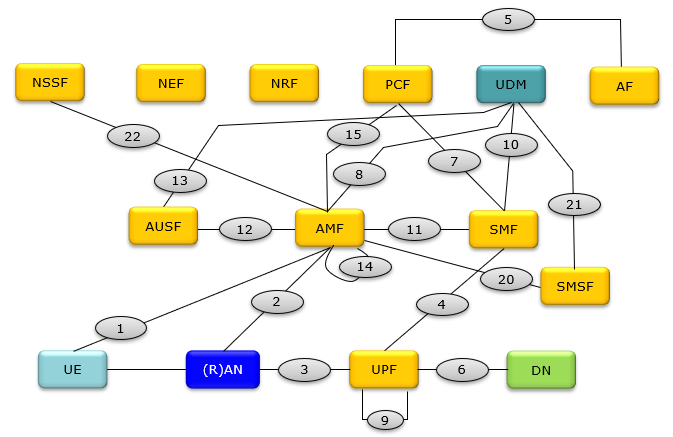|
|
||
|
The 5G core network architecture is based on a service-based model, utilizing cloud-native and virtualized network functions. The purpose of this note is to share you with overview of 5G corenetwork. The defails of specific components and functionalities will be described in separate notes.
Overall ArchitectureFollowing is the overal NR Network illustrated based on 23.501. The diagram is based mainly on Figure 4.2.3-1 and Figure 4.2.3-2 of 23.501. The numbers in the oval shape indicates the reference point between components. This shows NR network only in non-roaming condition. In the condition of roaming with other NR network or Legacy network, some additional function block and interface(reference point) is required.
Components of the NetworkThere are so many components and functionality. Some of Key components include the Access and Mobility Management Function (AMF), Session Management Function (SMF), User Plane Function (UPF), and Network Repository Function (NRF). The architecture enables network slicing, end-to-end QoS, and efficient resource management. Followings are the name of each network component. This is the list of the component that are likely to be commonly used in most of the networks, but depending on real deployment you may see more components or in some cases (like small scale private network) you may see much less components where multiple functionalities are aggregated into one component) AMF Access and Mobility Management Function ==> Equivalent to MME in 4G AUSF Authentication Server Function DN Data Network NEF Network Exposure Function NRF Network Repository Function NSSF Network Slice Selection Function PCF Policy Control Function ==> Equivalent to PCRF in 4G (R)AN (Radio) Access Network SMF Session Management Function UDM Unified Data Management ==> Equivalent to HSS in 4G UPF User Plane Function ==> Equivalent to PGW in 4G SMSF SMS Function Interfaces between ComponentsFollowings are the reference point definition specified in 23.501 - 4.2.7. A reference point is a conceptual point of interaction between two network functions or components. N1: Reference point between the UE and the AMF. N2: Reference point between the (R)AN and the AMF. N3: Reference point between the (R)AN and the UPF. N4: Reference point between the SMF and the UPF. N6: Reference point between the UPF and a Data Network. N9: Reference point between two UPFs. N5: Reference point between the PCF and an AF. N7: Reference point between the SMF and the PCF. N8: Reference point between the UDM and the AMF. N10: Reference point between the UDM and the SMF. N11: Reference point between the AMF and the SMF. N12: Reference point between AMF and AUSF. N13: Reference point between the UDM and Authentication Server function the AUSF. N14: Reference point between two AMFs. N15: Reference point between the PCF and the AMF in the case of non-roaming scenario, PCF in the visited network and AMF in the case of roaming scenario. N16: Reference point between two SMFs, (in roaming case between SMF in the visited network and the SMF in the home network). N16a: Reference point between SMF and I-SMF. N17: Reference point between AMF and 5G-EIR. N18: Reference point between any NF and UDSF. N19: Reference point between two PSA UPFs for 5G LAN-type service. N22: Reference point between AMF and NSSF. N23: Reference point between PCF and NWDAF. N24: Reference point between the PCF in the visited network and the PCF in the home network. N26: Reference point between MME (4G) and AMF N27: Reference point between NRF in the visited network and the NRF in the home network. N28: Reference point between PCF and CHF. N29: Reference point between NEF and SMF. N30: Reference point between PCF and NEF. N31: Reference point between the NSSF in the visited network and the NSSF in the home network. N32: Reference point between SEPP in the visited network and the SEPP in the home network. N33: Reference point between NEF and AF. N34: Reference point between NSSF and NWDAF. N35: Reference point between UDM and UDR. N36: Reference point between PCF and UDR. N37: Reference point between NEF and UDR. N38: Reference point between I-SMFs. N40: Reference point between SMF and the CHF. N50: Reference point between AMF and the CBCF. N51: Reference point between AMF and NEF. N52: Reference point between NEF and UDM. N55: Reference point between AMF and the UCMF. N56: Reference point between NEF and the UCMF. N57: Reference point between AF and the UCMF. N41: Reference point between AMF and the CHF in HPLMN. N42: Reference N58: Reference point between AMF and the NSSAAF. N59: Reference point between UDM and the NSSAAF. Design Philosophy of 5G Core networkAt first glance, you may think 5G core is too complicated and look over-designed. There is some design philosophy behind the architecture.
Reference
YouTube
|
||
